Can We Predict Tomorrow’s Average Rainfall in Australia?
We’ll pull apart the dataset, do the usual EDA, followed up with some time-series decomposition, feature extraction and basic deep learning for forecasting.
Data Source here
import pandas as pd
import numpy as np
import matplotlib.pyplot as plt
import seaborn as sns
Exploration
We can see that the dataset is already setup quite nicely. The initial goal is to predict ‘RainTomorrow’, where the variable has already been setup correctly for analysis. We’ve got all of the typical components: temperature, wind direction, wind speed, humidity and pressure. My initial suspicions are that the 3pm pressure and 3pm humidity components, as well as location, will be the key drivers of whether it will rain tomorrow.
df = pd.read_csv(r"D:\Downloads\weatherAUS.csv\weatherAUS.csv")
df.info()
<class 'pandas.core.frame.DataFrame'>
RangeIndex: 145460 entries, 0 to 145459
Data columns (total 24 columns):
Date 145460 non-null object
Location 145460 non-null object
MinTemp 143975 non-null float64
MaxTemp 144199 non-null float64
Rainfall 142199 non-null float64
Evaporation 82670 non-null float64
Sunshine 75625 non-null float64
WindGustDir 135134 non-null object
WindGustSpeed 135197 non-null float64
WindDir9am 134894 non-null object
WindDir3pm 141232 non-null object
WindSpeed9am 143693 non-null float64
WindSpeed3pm 142398 non-null float64
Humidity9am 142806 non-null float64
Humidity3pm 140953 non-null float64
Pressure9am 130395 non-null float64
Pressure3pm 130432 non-null float64
Cloud9am 89572 non-null float64
Cloud3pm 86102 non-null float64
Temp9am 143693 non-null float64
Temp3pm 141851 non-null float64
RainToday 142199 non-null object
RISK_MM 142193 non-null float64
RainTomorrow 142193 non-null object
dtypes: float64(17), object(7)
memory usage: 26.6+ MB
df.head()
| Date | Location | MinTemp | MaxTemp | Rainfall | Evaporation | Sunshine | WindGustDir | WindGustSpeed | WindDir9am | ... | Humidity3pm | Pressure9am | Pressure3pm | Cloud9am | Cloud3pm | Temp9am | Temp3pm | RainToday | RISK_MM | RainTomorrow | |
|---|---|---|---|---|---|---|---|---|---|---|---|---|---|---|---|---|---|---|---|---|---|
| 0 | 2008-12-01 | Albury | 13.4 | 22.9 | 0.6 | NaN | NaN | W | 44.0 | W | ... | 22.0 | 1007.7 | 1007.1 | 8.0 | NaN | 16.9 | 21.8 | No | 0.0 | No |
| 1 | 2008-12-02 | Albury | 7.4 | 25.1 | 0.0 | NaN | NaN | WNW | 44.0 | NNW | ... | 25.0 | 1010.6 | 1007.8 | NaN | NaN | 17.2 | 24.3 | No | 0.0 | No |
| 2 | 2008-12-03 | Albury | 12.9 | 25.7 | 0.0 | NaN | NaN | WSW | 46.0 | W | ... | 30.0 | 1007.6 | 1008.7 | NaN | 2.0 | 21.0 | 23.2 | No | 0.0 | No |
| 3 | 2008-12-04 | Albury | 9.2 | 28.0 | 0.0 | NaN | NaN | NE | 24.0 | SE | ... | 16.0 | 1017.6 | 1012.8 | NaN | NaN | 18.1 | 26.5 | No | 1.0 | No |
| 4 | 2008-12-05 | Albury | 17.5 | 32.3 | 1.0 | NaN | NaN | W | 41.0 | ENE | ... | 33.0 | 1010.8 | 1006.0 | 7.0 | 8.0 | 17.8 | 29.7 | No | 0.2 | No |
5 rows × 24 columns
df['Date'] = pd.to_datetime(df['Date'])
df['Year-Mon'] = [x.strftime("%Y-%m") for x in df['Date']]
Average Rainfall
If we look at the daily average rainfall, we can see that it’s pretty noisy (as expected), and quite difficult to see any obvious trends. This is not unexpected as we’ve averaged across the entire location universe, and so we end up with a process that looks quite stationary.
df.groupby(['Date'])['Rainfall'].mean().plot(figsize=(15,10))
plt.show()

df.groupby(['Year-Mon'])['Rainfall'].mean().plot(figsize=(15,10))
plt.show()

Location Analysis
Our dataset isn’t huge, and only has a selection of . If we look at the average min/max temperatures and then take the largest spread, we see that the desert locations have the largest spread, whilst coastal regions seem to be a bit more stable.
temp_avg = df.groupby(['Location']).mean()[['MinTemp', 'MaxTemp']]
temp_avg['Delta'] = temp_avg['MaxTemp'] - temp_avg['MinTemp']
temp_avg.sort_values(by='Delta', ascending=True).plot(kind='barh', figsize=(15,10))
plt.show()
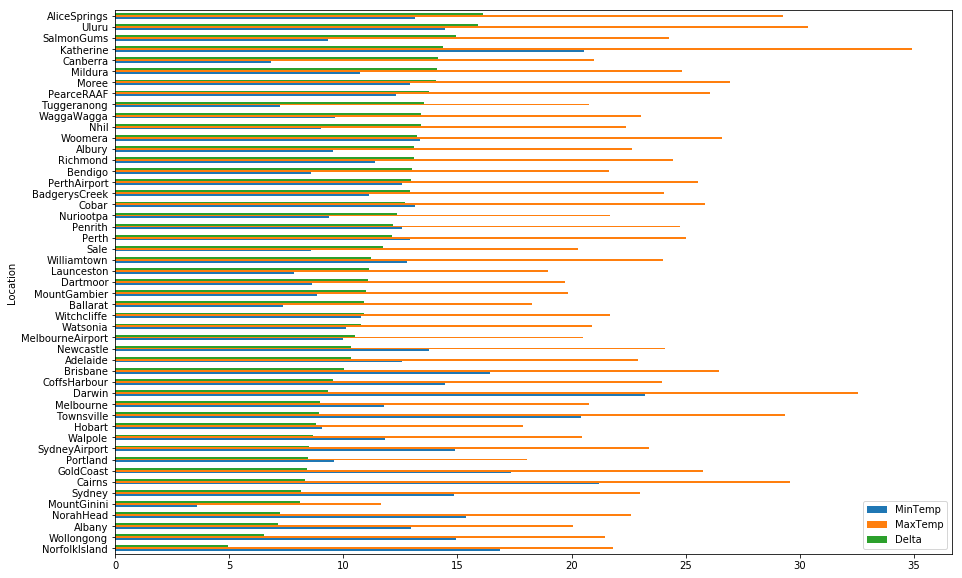
Correlations
Let’s see if we can pull out some correlations between locations based on temperature and rainfall. We do get ~4-5 clusters of locations with similar rainfall patterns: Sydney region (Sydney, Penrith, Richmond, etc.), Perth, Central Australia and Southern Australia (Melbourne, Tasmania).
temp_by_loc = df.groupby(['Date', 'Location'])['MaxTemp'].sum().unstack()
sns.clustermap(temp_by_loc.corr(), figsize=(15,15))
plt.show()
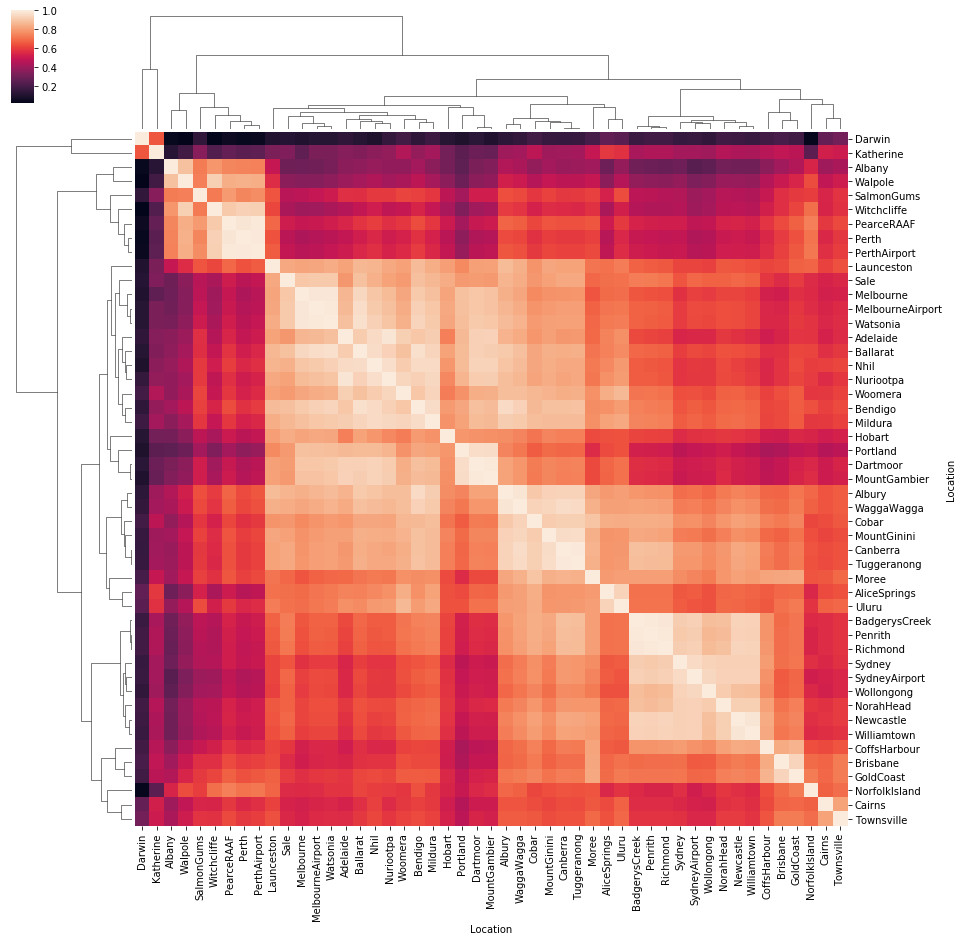
temp_by_loc = df.groupby(['Date', 'Location'])['Rainfall'].sum().unstack()
sns.clustermap(temp_by_loc.corr(), figsize=(15,15))
plt.show()
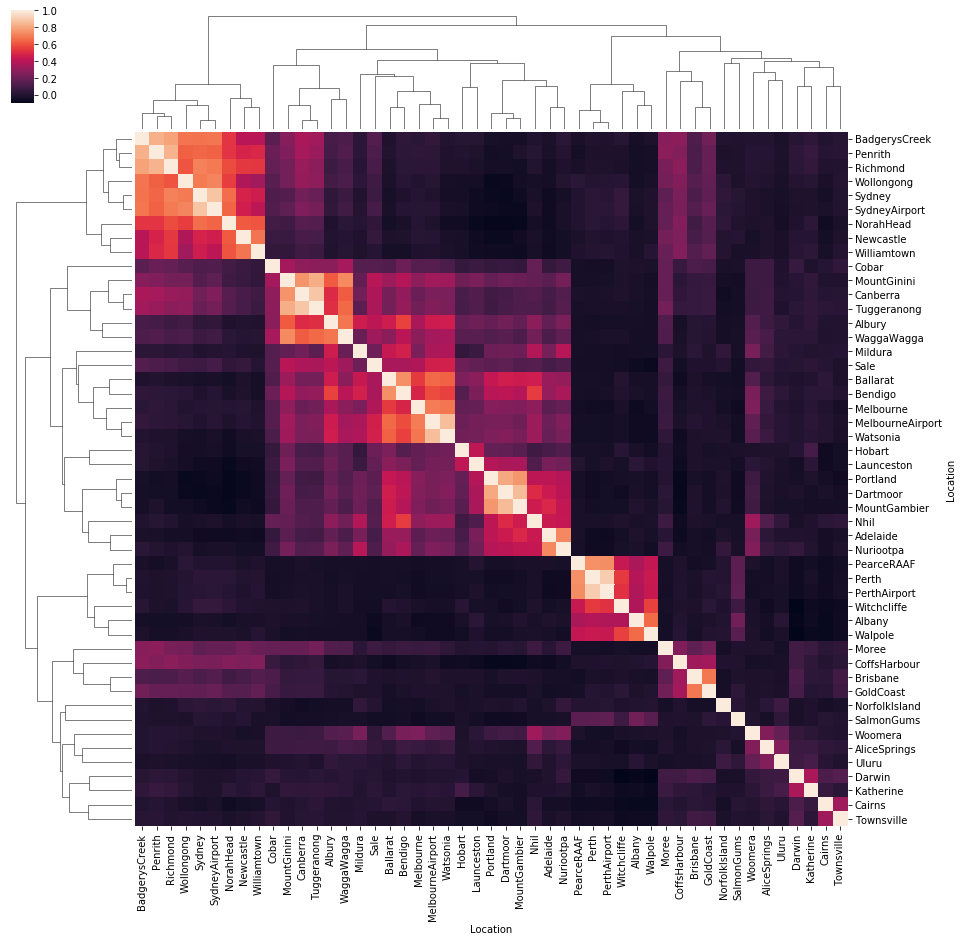
df.groupby(['Date', 'Location'])['MinTemp'].sum().unstack().plot(figsize=(15,10))
plt.legend('')
plt.show()
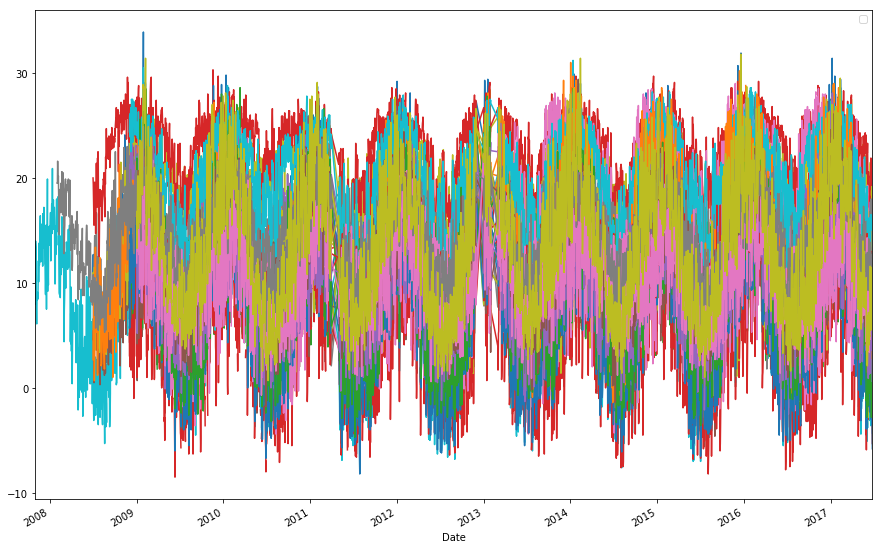
df.groupby(['Date', 'Location'])['MaxTemp'].sum().unstack().plot(figsize=(15,10))
plt.legend('')
plt.show()
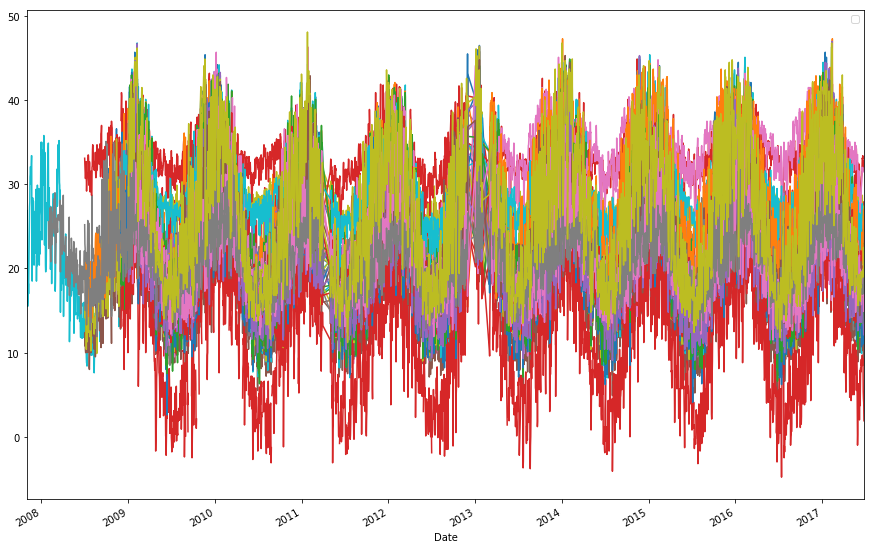
Correlation Across the Dataset
First we’ll need to convert the few categorical variables into continuous variables, we’ll do this using the basic LabelEncoder. We can then see that Rain Tomorrow appears in a cluster with RainToday, Rainfall, Humidity and Cloud.
cat_f = [x for x in df.columns if df[x].dtype == 'object']
for name in cat_f:
enc = preprocessing.LabelEncoder()
enc.fit(list(df[name].values.astype('str')) + list(df[name].values.astype('str')))
df[name] = enc.transform(df[name].values.astype('str'))
sns.clustermap(df.corr())
plt.show()

Time-Series Decomposition
import statsmodels.api as sm
from statsmodels.tsa.stattools import acf
from statsmodels.tsa.stattools import pacf
from statsmodels.tsa.seasonal import seasonal_decompose
C:\Users\Clint_PC\Anaconda3\lib\site-packages\statsmodels\compat\pandas.py:56: FutureWarning: The pandas.core.datetools module is deprecated and will be removed in a future version. Please use the pandas.tseries module instead.
from pandas.core import datetools
decomposition = seasonal_decompose(df.groupby(['Date'])['Rainfall'].mean(), freq=365)
fig = plt.figure(figsize=(15,10))
fig = decomposition.plot()
fig.set_size_inches(15, 8)
plt.show()
<matplotlib.figure.Figure at 0x2b033f34c50>

year_mon_avg = df.groupby(['Year-Mon'])['Rainfall'].mean()
year_mon_avg.index = pd.to_datetime(year_mon_avg.index)
decomposition = seasonal_decompose(year_mon_avg, freq=12)
fig = plt.figure(figsize=(15,10))
fig = decomposition.plot()
fig.set_size_inches(15, 8)
plt.show()
<matplotlib.figure.Figure at 0x2b033c596a0>
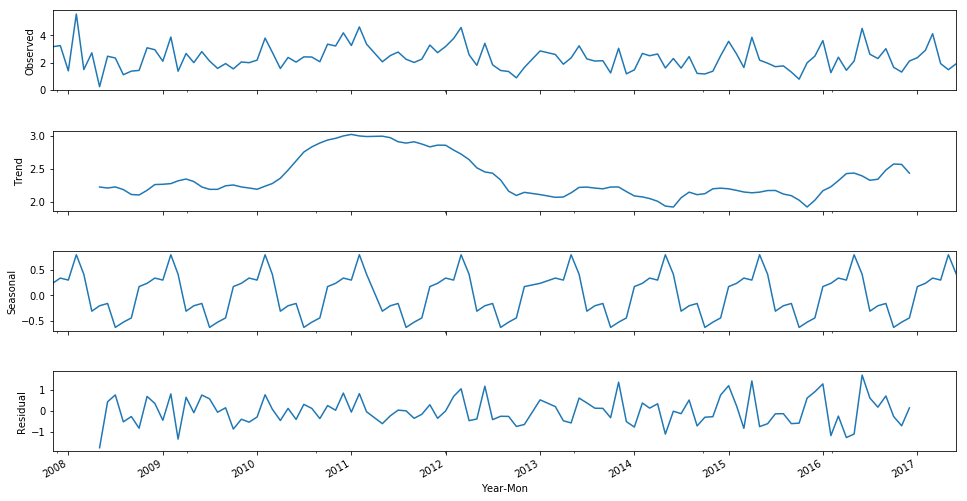
decomposition = seasonal_decompose(df.loc[df.Location == 'Sydney'].groupby(['Date'])['Rainfall'].sum().dropna(), freq=365)
fig = plt.figure(figsize=(15,10))
fig = decomposition.plot()
fig.set_size_inches(15, 8)
plt.show()
<matplotlib.figure.Figure at 0x2b03726b4e0>
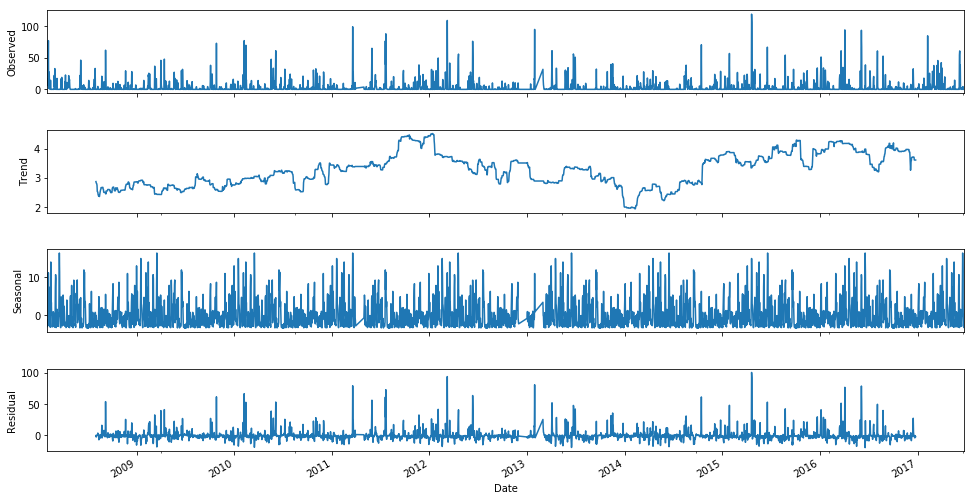
Feature Selection
#Preprocessing
from sklearn import preprocessing
from sklearn.model_selection import train_test_split
from sklearn.preprocessing import StandardScaler
#Algos
from sklearn.linear_model import LogisticRegression
from sklearn.neighbors import KNeighborsClassifier
from sklearn.ensemble import RandomForestClassifier
from sklearn.svm import SVC
from xgboost import XGBClassifier
#Postprocessing
from sklearn.feature_selection import SelectFromModel
from sklearn.metrics import accuracy_score
from xgboost import plot_importance
C:\Users\Clint_PC\Anaconda3\lib\site-packages\sklearn\cross_validation.py:41: DeprecationWarning: This module was deprecated in version 0.18 in favor of the model_selection module into which all the refactored classes and functions are moved. Also note that the interface of the new CV iterators are different from that of this module. This module will be removed in 0.20.
"This module will be removed in 0.20.", DeprecationWarning)
cat_f = [x for x in df.columns if df[x].dtype == 'object']
for name in cat_f:
enc = preprocessing.LabelEncoder()
enc.fit(list(df[name].values.astype('str')) + list(df[name].values.astype('str')))
df[name] = enc.transform(df[name].values.astype('str'))
X_train = df.drop(['Date','RainTomorrow', 'Year-Mon', 'RISK_MM'], axis=1)
y_train = df['RainTomorrow']
X_train.fillna(-1000, inplace=True)
# our test dataset doesn't have a target variable, so we'll have to test on the train df using holdout
x_train, x_test, y_train, y_test = train_test_split(X_train, y_train, test_size=0.2)
clf3 = XGBClassifier()
clf3.fit(x_train, y_train)
print("XGBoost Score = ", clf3.score(x_test, y_test))
As expected above, location, humidity and pressure all appear at the top of the feature importance range!
ax = plot_importance(clf3)
fig = ax.figure
fig.set_size_inches(15, 10)
plt.show()
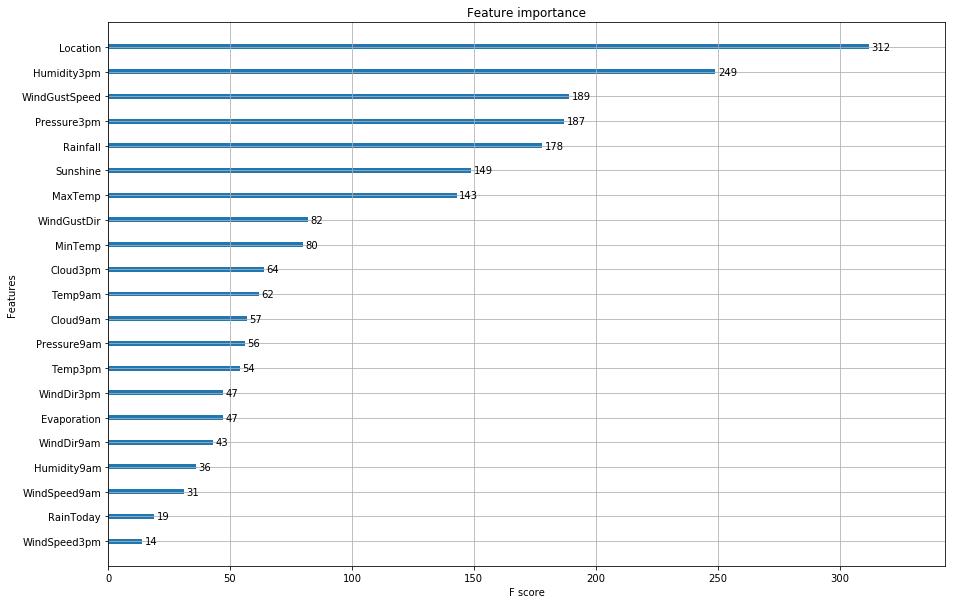
Deep Learning
#credit for help: https://machinelearningmastery.com/multivariate-time-series-forecasting-lstms-keras/
We’ll show just how easy using Keras is to build an LSTM model, train it and then use it to forecast our variables. This process highlights how easy it is to just use and abuse a model without actually understanding what’s going on, use with care!
The conclusion is that it’s quite difficult to predict rainfall tomorrow based on using only variables from the previous day, as we don’t seem to be able to pick up the large swings that tend to occur. However, if we bring in current day variables, our forecast accuracy increases substantially. What this suggests is that there is likely a set of conditions which exist to cause rainfall and when these all simultaneously occur, we get the magic of rain. This is when things like humidity/pressure/cloud/wind speed all play in, as they all tie into the properties of water and impact on weather patterns.
from sklearn.preprocessing import MinMaxScaler
from sklearn.metrics import mean_squared_error
from sklearn.model_selection import train_test_split
from sklearn.metrics import mean_squared_error
from keras.models import Sequential
from keras.layers import Dense
from keras.layers import LSTM
#credit to machine learning mastery
#https://machinelearningmastery.com/multivariate-time-series-forecasting-lstms-keras/
# convert series to supervised learning
def series_to_supervised(data, n_in=1, n_out=1, dropnan=True):
n_vars = 1 if type(data) is list else data.shape[1]
df = pd.DataFrame(data)
cols, names = list(), list()
# input sequence (t-n, ... t-1)
for i in range(n_in, 0, -1):
cols.append(df.shift(i))
names += [('var%d(t-%d)' % (j+1, i)) for j in range(n_vars)]
# forecast sequence (t, t+1, ... t+n)
for i in range(0, n_out):
cols.append(df.shift(-i))
if i == 0:
names += [('var%d(t)' % (j+1)) for j in range(n_vars)]
else:
names += [('var%d(t+%d)' % (j+1, i)) for j in range(n_vars)]
# put it all together
agg = pd.concat(cols, axis=1)
agg.columns = names
# drop rows with NaN values
if dropnan:
agg.dropna(inplace=True)
return agg
Predicting Using Only Historical Variables
def run_preds_city(df, city, groupby='Date'):
df = df.loc[df['Location'] == city]
cat_f = [x for x in df.columns if df[x].dtype == 'object']
for name in cat_f:
enc = preprocessing.LabelEncoder()
enc.fit(list(df[name].values.astype('str')) + list(df[name].values.astype('str')))
df[name] = enc.transform(df[name].values.astype('str'))
combined_df = df.groupby([groupby]).mean()
combined_df['RainfallPred'] = combined_df['Rainfall'].shift(1)
combined_df.drop(['Rainfall'], axis=1, inplace=True)
#combined_df = combined_df[['Humidity3pm', 'WindGustSpeed', 'Pressure3pm', 'Sunshine', 'MaxTemp', 'WindGustDir', 'MinTemp', 'Rainfall']]
lstm_dataset = combined_df.values
lstm_dataset = lstm_dataset.astype('float32')
reframed = combined_df
reframed.dropna(inplace=True)
column_names = reframed.columns
# normalize the dataset
scaler = MinMaxScaler(feature_range=(-1, 1))
reframed = scaler.fit_transform(reframed)
# frame as supervised learning
reframed = pd.DataFrame(reframed, columns=column_names)
# split into train and test sets# split
values = reframed.values
forecast_period = np.round(len(values)*0.8, 0).astype(int)
train = values[:forecast_period, :]
test = values[forecast_period:, :]
# split into input and outputs
train_X, train_y = train[:, :-1], train[:, -1]
test_X, test_y = test[:, :-1], test[:, -1]
# reshape input to be 3D [samples, timesteps, features]
train_X = train_X.reshape((train_X.shape[0], 1, train_X.shape[1]))
test_X = test_X.reshape((test_X.shape[0], 1, test_X.shape[1]))
# design network
lstm_model = Sequential()
lstm_model.add(LSTM(50, input_shape=(train_X.shape[1], train_X.shape[2])))
lstm_model.add(Dense(1))
lstm_model.compile(loss='mae', optimizer='adam')
# fit network
history = lstm_model.fit(train_X, train_y, epochs=50, batch_size=72, validation_data=(test_X, test_y), verbose=0, shuffle=False)
# plot history
plt.plot(history.history['loss'], label='train')
plt.plot(history.history['val_loss'], label='test')
plt.legend()
plt.show()
# make a prediction
yhat = lstm_model.predict(test_X)
#to reverse MinMax reshape based on original shape
test_X = test_X.reshape((test_X.shape[0], test_X.shape[2]))
# invert scaling for forecast
inv_yhat = np.concatenate((test_X[:, 0:], yhat), axis=1)
inv_yhat = scaler.inverse_transform(inv_yhat)
inv_yhat = inv_yhat[:,-1]
# invert scaling for actual
test_y = test_y.reshape((len(test_y), 1))
inv_y = np.concatenate((test_X[:,0:], test_y), axis=1)
inv_y = scaler.inverse_transform(inv_y)
inv_y = inv_y[:,-1]
# calculate RMSE
rmse = np.sqrt(mean_squared_error(inv_y, inv_yhat))
rmse_title_lstm = 'Test RMSE: %.3f' % rmse
lstm_predictions = [np.nan for _ in range(0,len(train_X))]
combined_df['LSTM Prediction'] = lstm_predictions + list(inv_yhat)
combined_df[['RainfallPred', 'LSTM Prediction']].plot( figsize=(15,10), title=rmse_title_lstm)
plt.show()
def run_preds(df, forecast_period, groupby='Date'):
combined_df = df.groupby([groupby]).mean()
combined_df['RainfallPred'] = combined_df['Rainfall'].shift(1)
combined_df.drop(['Rainfall'], axis=1, inplace=True)
#combined_df = combined_df[['Humidity3pm', 'WindGustSpeed', 'Pressure3pm', 'Sunshine', 'MaxTemp', 'WindGustDir', 'MinTemp', 'Rainfall']]
lstm_dataset = combined_df.values
lstm_dataset = lstm_dataset.astype('float32')
reframed = combined_df
reframed.dropna(inplace=True)
column_names = reframed.columns
# normalize the dataset
scaler = MinMaxScaler(feature_range=(-1, 1))
reframed = scaler.fit_transform(reframed)
# frame as supervised learning
reframed = pd.DataFrame(reframed, columns=column_names)
# split into train and test sets# split
values = reframed.values
train = values[:forecast_period, :]
test = values[forecast_period:, :]
# split into input and outputs
train_X, train_y = train[:, :-1], train[:, -1]
test_X, test_y = test[:, :-1], test[:, -1]
# reshape input to be 3D [samples, timesteps, features]
train_X = train_X.reshape((train_X.shape[0], 1, train_X.shape[1]))
test_X = test_X.reshape((test_X.shape[0], 1, test_X.shape[1]))
# design network
lstm_model = Sequential()
lstm_model.add(LSTM(50, input_shape=(train_X.shape[1], train_X.shape[2])))
lstm_model.add(Dense(1))
lstm_model.compile(loss='mae', optimizer='adam')
# fit network
history = lstm_model.fit(train_X, train_y, epochs=50, batch_size=72, validation_data=(test_X, test_y), verbose=0, shuffle=False)
# plot history
plt.plot(history.history['loss'], label='train')
plt.plot(history.history['val_loss'], label='test')
plt.legend()
plt.show()
# make a prediction
yhat = lstm_model.predict(test_X)
#to reverse MinMax reshape based on original shape
test_X = test_X.reshape((test_X.shape[0], test_X.shape[2]))
# invert scaling for forecast
inv_yhat = np.concatenate((test_X[:, 0:], yhat), axis=1)
inv_yhat = scaler.inverse_transform(inv_yhat)
inv_yhat = inv_yhat[:,-1]
# invert scaling for actual
test_y = test_y.reshape((len(test_y), 1))
inv_y = np.concatenate((test_X[:,0:], test_y), axis=1)
inv_y = scaler.inverse_transform(inv_y)
inv_y = inv_y[:,-1]
# calculate RMSE
rmse = np.sqrt(mean_squared_error(inv_y, inv_yhat))
rmse_title_lstm = 'Test RMSE: %.3f' % rmse
lstm_predictions = [np.nan for _ in range(0,len(train_X))]
combined_df['LSTM Prediction'] = lstm_predictions + list(inv_yhat)
combined_df[['RainfallPred', 'LSTM Prediction']].plot( figsize=(15,10), title=rmse_title_lstm)
plt.show()
run_preds_city(df, 'Sydney', 'Year-Mon')
C:\Users\Clint_PC\Anaconda3\lib\site-packages\ipykernel\__main__.py:10: SettingWithCopyWarning:
A value is trying to be set on a copy of a slice from a DataFrame.
Try using .loc[row_indexer,col_indexer] = value instead
See the caveats in the documentation: http://pandas.pydata.org/pandas-docs/stable/indexing.html#indexing-view-versus-copy
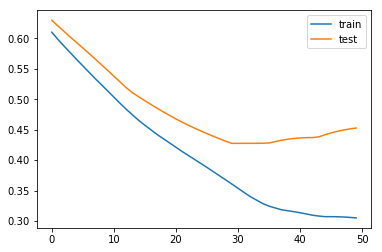
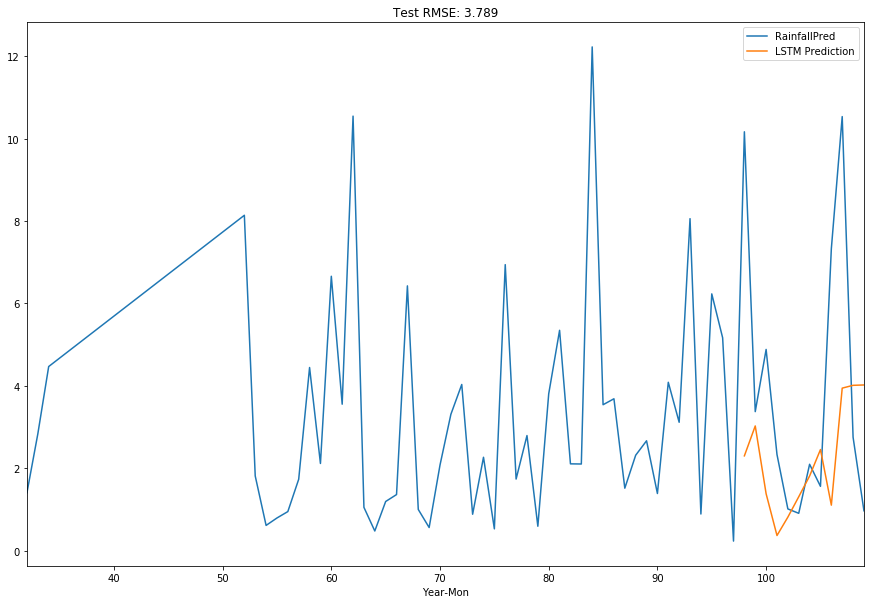
run_preds_city(df, 'Sydney', 'Date')
C:\Users\Clint_PC\Anaconda3\lib\site-packages\ipykernel\__main__.py:10: SettingWithCopyWarning:
A value is trying to be set on a copy of a slice from a DataFrame.
Try using .loc[row_indexer,col_indexer] = value instead
See the caveats in the documentation: http://pandas.pydata.org/pandas-docs/stable/indexing.html#indexing-view-versus-copy
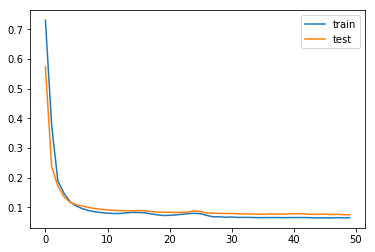
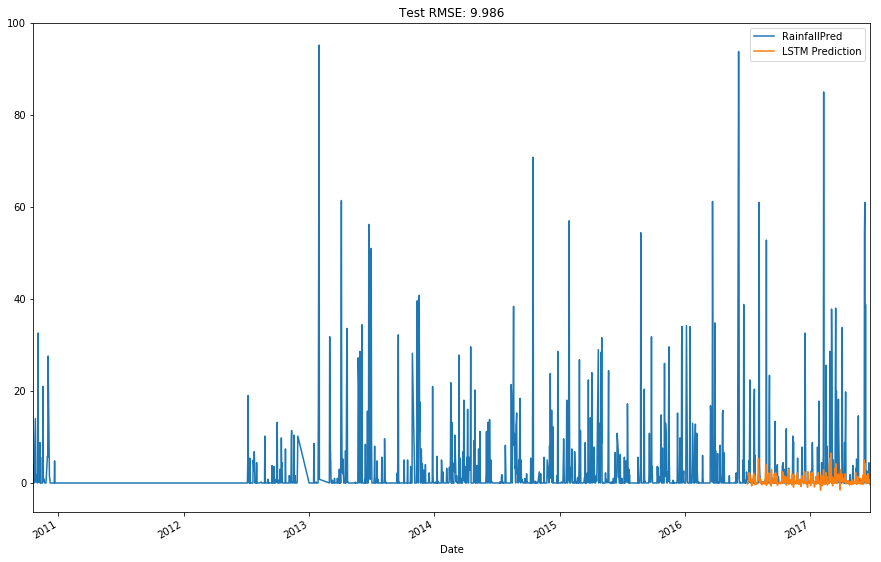
run_preds(df, 3200, 'Date')
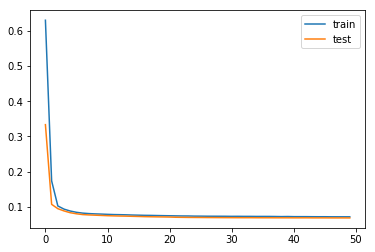

run_preds(df, 100, 'Year-Mon')
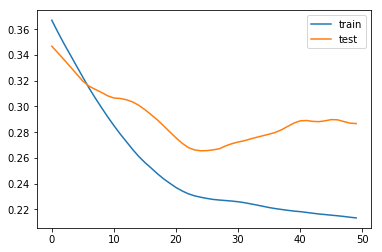
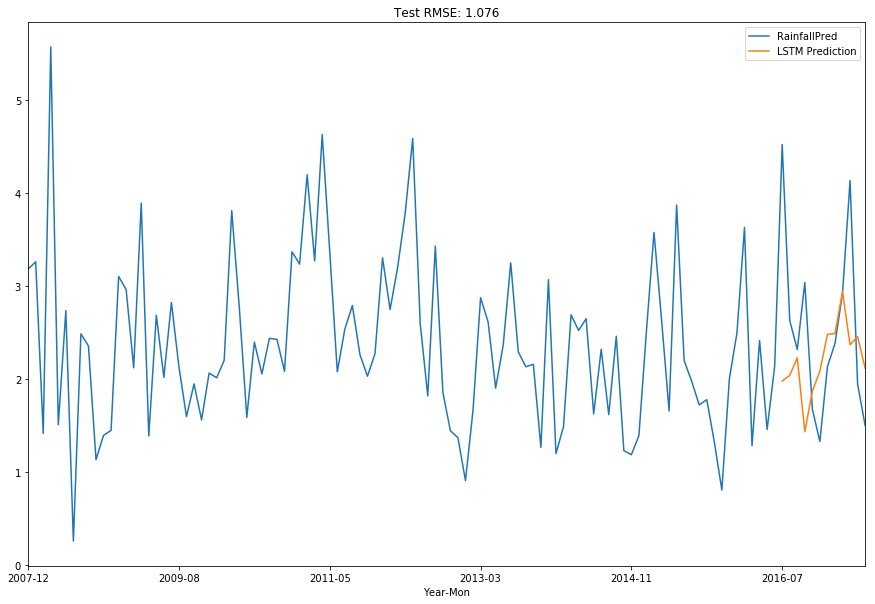
Predicting Using Current Days Variables
def run_preds_supervised(df, forecast_period, groupby='Date'):
combined_df = df.groupby([groupby]).mean()
#combined_df = combined_df[['Humidity3pm', 'WindGustSpeed', 'Pressure3pm', 'Sunshine', 'MaxTemp', 'WindGustDir', 'MinTemp', 'Rainfall']]
combined_df['RainfallPred'] = combined_df['Rainfall'].shift(1)
combined_df.drop(['Rainfall'], axis=1, inplace=True)
combined_df.dropna(inplace=True)
lstm_dataset = combined_df.values
lstm_dataset = lstm_dataset.astype('float32')
reframed = series_to_supervised(lstm_dataset, 1, 1)
column_names = reframed.columns
# normalize the dataset
scaler = MinMaxScaler(feature_range=(-1, 1))
reframed = scaler.fit_transform(reframed)
# frame as supervised learning
reframed = pd.DataFrame(reframed, columns=column_names)
# split into train and test sets# split
values = reframed.values
train = values[:forecast_period, :]
test = values[forecast_period:, :]
# split into input and outputs
train_X, train_y = train[:, :-1], train[:, -1]
test_X, test_y = test[:, :-1], test[:, -1]
# reshape input to be 3D [samples, timesteps, features]
train_X = train_X.reshape((train_X.shape[0], 1, train_X.shape[1]))
test_X = test_X.reshape((test_X.shape[0], 1, test_X.shape[1]))
# design network
lstm_model = Sequential()
lstm_model.add(LSTM(50, input_shape=(train_X.shape[1], train_X.shape[2])))
lstm_model.add(Dense(1))
lstm_model.compile(loss='mae', optimizer='adam')
# fit network
history = lstm_model.fit(train_X, train_y, epochs=50, batch_size=72, validation_data=(test_X, test_y), verbose=0, shuffle=False)
# plot history
plt.plot(history.history['loss'], label='train')
plt.plot(history.history['val_loss'], label='test')
plt.legend()
plt.show()
# make a prediction
yhat = lstm_model.predict(test_X)
#to reverse MinMax reshape based on original shape
test_X = test_X.reshape((test_X.shape[0], test_X.shape[2]))
# invert scaling for forecast
inv_yhat = np.concatenate((test_X[:, 0:], yhat), axis=1)
inv_yhat = scaler.inverse_transform(inv_yhat)
inv_yhat = inv_yhat[:,-1]
# invert scaling for actual
test_y = test_y.reshape((len(test_y), 1))
inv_y = np.concatenate((test_X[:,0:], test_y), axis=1)
inv_y = scaler.inverse_transform(inv_y)
inv_y = inv_y[:,-1]
# calculate RMSE
rmse = np.sqrt(mean_squared_error(inv_y, inv_yhat))
rmse_title_lstm = 'Test RMSE: %.3f' % rmse
lstm_predictions = [np.nan for _ in range(0,len(train_X)+1)]
combined_df['LSTM Prediction'] = lstm_predictions + list(inv_yhat)
combined_df[['RainfallPred', 'LSTM Prediction']].plot( figsize=(15,10), title=rmse_title_lstm)
plt.show()
run_preds_supervised(df, 3200, 'Date')

